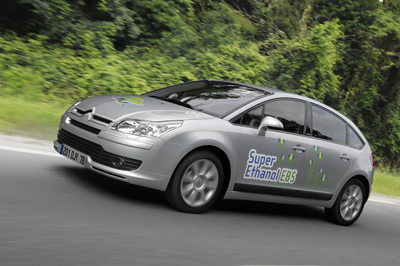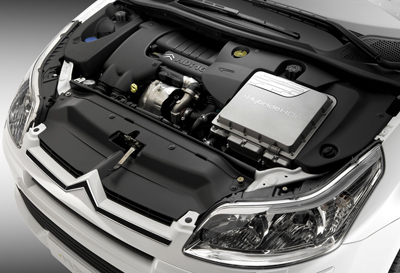CitroŽn at the 2007 Internationale
Automobil-Ausstellung in Frankfurt
|
 |
CitroŽn displays its 2008 range at the Frankfurt
Motor Show
|

|
|
General summary
CitroŽn
has become one of the most advanced manufacturers on
environmental
protection owing to its ambitious policy in this area:
- 55% of CitroŽn vehicles emit less than 140 g of
CO2 per km, and 24% emit less than 120 g/km.
- CitroŽn has an 11% share of the European market
for vehicles emitting less than 141 g/km of CO2.
- The marque has sold more than 500,000 vehicles
fitted with a particulate filter.
At
the 2007 Frankfurt Motor Show, CitroŽn is confirming
its position as a
leading full-line manufacturer at the forefront of
innovation:
highlighting its commitment and technological prowess
in environmental protection :
- by launching the AIRDREAM signature that
underlines the environmental credentials of models
in the range;
- by presenting the C4 BioFlex running on
superethanol E85;
showcasing two concept cars:
- C-Cactus, an essential vehicle offering access to
hybrid HDi for the price of an entry-level family
saloon,
- C5 Airscape, a luxury cabriolet combining
environmental protection and automotive pleasure;
- offering
the fullest range in its history, made up of 11
saloons and estates,
four people carriers, a van-based MPV and a new SUV,
C-Crosser;
- presenting its potential for innovation through
educational demonstrators that show how, among
others, the DPFS,
6-speed EGS, emergency call and Snow Motion system
work.
At the 2007 Frankfurt Motor Show, CitroŽn
is confirming its position as a leading full-line
manufacturer at the
forefront of innovation with:
- C4 BioFlex, a
car expanding an environmental range that already
meets high standards
of performance. A range promoted by the AIRDREAM
label, which allows
customers to identify the models with the best
environmental
credentials;
- C-Cactus and C5 Airscape, two ecological concept
cars
with strong personalities. Like earlier prototypes,
these vehicles
demonstrate CitroŽn's expertise and test new
solutions for the future;
- the fullest range in its history, made up of
eleven saloons, four people-carriers, a van-based
MPV and a new SUV, C-Crosser;
- a number of educational demonstrators that express
CitroŽn's potential for innovation.
|
AN AFFORDABLE ENVIRONMENTAL OFFERING MEETING
HIGH STANDARDS OF PERFORMANCE
CitroŽn is illustrating its environmental expertise
at the Frankfurt show by:
- launching the AIRDREAM environmental signature
that identifies the vehicles with the best
environmental credentials;
- exhibiting all the vehicles in its range fitted
with environmental technologies;
- underlining
its commitment to biofuels (superethanol with C4
Bio Flex and biodiesel
with all the HDi diesels) and natural gas (C3 and
Berlingo CNG);
- showing the public how Hybrid HDi, DPFS and
UrbanHybrid technologies work using educational
demonstrators.
AIRDREAM, a signature identifying the vehicles
with the best environmental credentials
To
highlight its commitment to the environment and
demonstrate its
technological expertise in this area, CitroŽn has
developed the
AIRDREAM signature for the cleanest vehicles in its
range.
AIRDREAM
reflects CitroŽn's efforts to contribute actively to
air quality and a
clean environment by cutting the pollutant emissions
from its vehicles.
To qualify for the AIRDREAM signature, vehicles
must meet the three criteria below:
1 Ė CO2 emissions = 130g for
vehicles running on fossil fuels
- 158
g for diesel vehicles equipped with the DPFS and
biodiesel B30
compatible (equal to 130g as part of a
well-to-wheel approach)
- 200 g for vehicles running on superethanol
E85 (equal to 120 g as part of a well-to-wheel
approach)
Or a Stop & Start vehicle
- (No CO2 emissions and no noise when
stationary)
Or a CNG vehicle
- (20% fewer CO2 emissions than a
petrol engine)
2 Ė Be manufactured in a plant that is ISO 14001
certified
3 Ė Be designed to be 95% recoverable (recycling
and energy recovery) by weight at end-of-life
List of CitroŽn vehicles
meeting these criteria
As
part of its policy to maintain and continuously
improve standards of
customer service, CitroŽn will expand the scope of
this signature in
the future to include any new technologies and new
developments able to
bring further reductions in pollutant emissions.
|
Environmental technology designed and marketed
by CitroŽn
Faithful
to its tradition of innovation, CitroŽn has long
sought to develop and
market vehicles equipped with ecologically sound
technologies.
After pioneering "zero emission" vehicles with the
AX Electric in 1995:
- CitroŽn
was one of the first manufacturers to bring a Stop
& Start system
to market. Available on the C2 and C3, this system
cuts fuel
consumption in urban driving conditions by around
10% (and even 15% in
dense traffic) while reducing CO2
emissions by around 15 g/km.
- The
Marque was also one of the first to develop and
sell a particulate
filter, now fitted on most of the HDi engines.
This system is
remarkably efficient in cutting fuel consumption
and pollutant
emissions (fuel consumption cut by 20% to 35%
compared with an
equivalent-capacity petrol engine).
CitroŽn is displaying a demonstrator at Frankfurt
to show the advantages of the DPFS.
Alongside
these technologies, CitroŽn also has two automated
manual gearboxes:
SensoDrive (for the C1, C2, C3 and C3 Pluriel) and
the six-speed
electronic gearbox system (for the C4, C4 Picasso
and Grand C4
Picasso). These gearboxes cut fuel consumption and
CO2 emissions by between 3% and 5%.
|
Credible products in the field of biofuels and CNG
With the C4 BioFlex,
premiering at the Frankfurt Motor Show this year,
CitroŽn is restating its commitment to green fuels.
Building
on the significant experience acquired over a number
of years in
Brazil, where it has sold more than 42,000 flexfuel
vehicles (65% of
local sales in 2006, with the C3 and Xsara Picasso),
CitroŽn is
launching the C4 BioFlex
in September. This model will be available only in
France and Sweden in the first instance.
This
flexfuel vehicle boasts remarkable environmental
credentials: the use
of superethanol E85 (a blend of 85% ethanol and 15%
petrol) limits CO2 emissions to 160 g/km,
compared with 169g/km for the same engine running on
traditional super unleaded.
CitroŽn
is pursuing a similarly active policy in the area of
biodiesel fuel.
All the HDi engines sold by the brand since 1998 are
able to run on
fuel containing up to 30% biodiesel without
modification. The low fuel
consumption and CO2 emissions of HDi
engines are thus combined with a renewable
energy.
Also
at the Frankfurt Motor Show, CitroŽn is displaying a
C3 1.4i CNG
equipped with a dual-fuel petrol/compressed natural
gas system. A
Berlingo equipped with the same engine is also
available. CNG boasts
excellent results in terms of environmental
performance, with a
reduction in CO2 emissions of 18% and 17%,
respectively, and
zero emissions of sulphur oxide and lead. At the same
time, it
contributes to sustainable development objectives
since reserves are
abundant.
|
|
 |
|

|
Innovating for the environment with the C4 Hybride
HDi and UrbanHybrid technology
At the 2007 Frankfurt Motor Show, CitroŽn is
presenting a number of solutions for the future. They
include:
- The C4 Hybride HDi,
allying the exceptional efficiency of the HDi diesel
engine with the
advantages of an electric motor made for urban
driving. This vehicle
combines high levels of performance with a
significant cut in both fuel
consumption (3.4 l/100 km over a combined cycle) and
CO2
emissions (90g/km). It also boasts increased range
and excellent
environmental results thanks to the complete absence
of noise and
pollutant emissions in electric mode.
A demonstrator on the stand simulates
operation of a C4 Hybride HDi. Visitors can observe
the action of each
vehicle part and its impact in terms of consumption
and CO2 emissions.
- The UrbanHybrid technology used on the C5
Airscape concept car and whose operation is
illustrated by a demonstrator.
This
system cuts out the engine just before the vehicle
comes to a
standstill (slowdowns, traffic lights, etc.). This
standby mode cuts
both average fuel consumption and CO2
emissions. At the same
time, it temporarily stores large quantities of energy
during
deceleration in order to boost vehicle torque when
required.
|
|

|
TWO ECOLOGICAL CONCEPT CARS WITH
STRONG PERSONALITIES
In
keeping with CitroŽn's tradition of innovation, the
environment is a
priority in research programmes. This concerns not
only developing and
marketing "clean" vehicles but also designing and
perfecting concept
cars. The Marque is presenting two new ecological
concept cars at the
Frankfurt Motor Show: C-Cactus and C5 Airscape.
|
|
C-Cactus: a new take on the
ecological car
With
C-Cactus, CitroŽn has developed a new take on the car,
focused on
essential values. A minimalist vehicle with fun,
attractive looks,
C-Cactus makes hybrid HDi technology more democratic
with an affordable
price tag.
C-Cactus uses new design processes that bring
down production costs. As a result, it costs no more
than an
entry-level C4, without sacrificing passenger comfort.
C5 Airscape: driveability and respect for the
environment
An
exceptional cabriolet, C5 Airscape features powerful,
dynamic exterior
styling and a prestige interior, made for the pleasure
of the driver
and the comfort of three passengers.
Styled for maximum
appeal, C5 Airscape also delivers maximum performance.
New-generation
traction control provides a level of traction close to
that of a
four-wheel drive. Alongside these remarkable levels of
performance, the
functions of the UrbanHybrid system limit fuel
consumption and emission
levels.
|
 |
|

|
|
CitroŽn uses its long tradition of innovation to
develop efficient environmental solutions
C-Cactus
and C-Airscape are the latest in a long line of
concept cars through
which CitroŽn has been able to develop its expertise
and credibility in
the field of environmental technology. Key concept
cars are:
- the Xsara Dynalto, forerunner to the Stop &
Start system (Geneva Motor Show Ė 1998),
- the
Saxo Dynavolt, an electric vehicle with a two-stroke
auxiliary engine
and an alternator-starter (Paris Motor Show Ė
1998),
- the Berlingo Dynavolt, an electric vehicle with an
auxiliary engine running on LPG (Geneva Motor Show Ė
1999),
- the Xsara Dynactive, a car using parallel hybrid
technology (Geneva Motor Show Ė 2000).
And more recently:
- the
C4 Hybride HDi, a demonstration vehicle with a
diesel hybrid drivetrain
that combines the exceptional efficiency of an HDi
diesel engine with
the benefits of an electric motor made for urban
driving (Geneva Motor
Show Ė 2006);
- C-Mťtisse, a diesel hybrid coupť featuring
electric
motors in its rear wheels. This configuration is
coherent with vehicle
performance and optimises traction (Paris Motor Show
Ė 2006);
- Cruise Crosser, a diesel hybrid SUV with a third
axle
that provides back-up for the four drive wheels on
difficult terrain
(sand, snow). Used alone, the third axle makes it
possible to drive in
ZEV ďZero Emission VehicleĒ mode (Geneva Motor Show
Ė 2007).
|
 |
© 2007 Julian
Marsh/CitroŽnŽt + SA Automobiles CitroŽn |
|
|